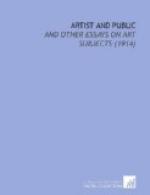Without any artificial aid from the government the illustrator has a wide popular support and works for the public in a normal way; and, therefore, illustration has been one of the healthiest and most vigorous forms of modern art. The portrait-painter, too, is producing something he knows to be wanted, and, though his art has had to fight against the competition of the photograph and has been partially vulgarized by the struggle of the exhibitions, it has yet remained, upon the whole, comprehensible and human; so that much of the soundest art of the past century has gone into portraiture. It is the painters of pictures, landscape or genre, who have most suffered from the misunderstanding between artist and public. Without guidance some of them have hewed a path to deserved success. Others have wandered into strange byways and no-thoroughfares.
The nineteenth century is strewn with the wrecks of such misunderstood and misunderstanding artists, but it was about the sixties when their searching for a way began to lead them in certain clearly marked directions. There are three paths, in especial, which have been followed since then by adventurous spirits: the paths of aestheticism, of scientific naturalism, and of pure self-expression; the paths of Whistler, of Monet, and of Cezanne.
Whistler was an artist of refined and delicate talent with great weaknesses both in temperament and training; being also a very clever man and a brilliant controversialist, he proceeded to erect a theory which should prove his weaknesses to be so many virtues, and he nearly succeeded in convincing the world of its validity. Finding the representation of nature very difficult, he decided that art should not concern itself with representation but only with the creation of “arrangements” and “symphonies.” Having no interest in the subject of pictures, he proclaimed that pictures




